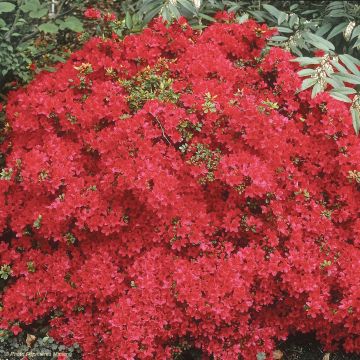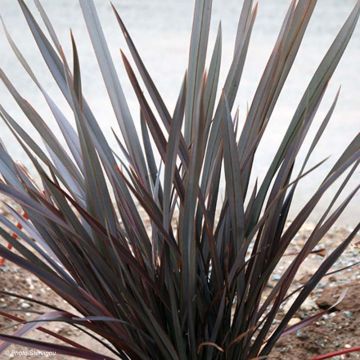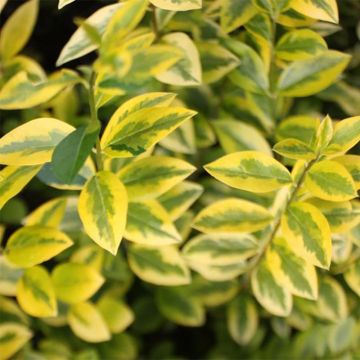

Rhododendron obtusum Fairy Dreams Three Sisters


Rhododendron obtusum Fairy Dreams Three Sisters
Rhododendron obtusum Fairy Dreams Three Sisters
Rhododendron (Azalea) obtusum Fairy Dreams® Three Sisters
Japanese Azalea
This item cannot be shipped to the selected country
Delivery charge from €5.90
More information
Schedule delivery date,
and select date in basket
This plant carries a 24 months recovery warranty
More information
We guarantee the quality of our plants for a full growing cycle, and will replace at our expense any plant that fails to recover under normal climatic and planting conditions.
From €5.90 for pickup delivery and €6.90 for home delivery
Express home delivery from €8.90.
Does this plant fit my garden?
Set up your Plantfit profile →
Description
The 'Fairy Dreams' 'Three Sisters' Japanese Azalea is a combination of 3 different coloured varieties in a single pot, like a bouquet of Azaleas. It is grown like a typical Japanese azalea, in acidic soil. This variety combines 3 or even 4 colours: white, orange, red, and pink funnel-shaped flowers. The nectar-rich flowers are produced profusely on a low shrub with shiny dark green foliage that almost disappears completely under the abundant flowers. This Azalea, like its Japanese counterparts, thrives in partial shade, in consistently moist soil, free from limestone.
The Fairy Dreams Three Sisters Japanese Azalea is part of a series of hybrids derived from Rhododendron obtusum. Rhododendron obtusum is now considered a hybrid of Rhododendron sataense, R. kiusinum, and R. kaempferi. It is a mostly evergreen shrub of the Ericaceae family. All these hardy plants are native to Japan, China, and Korea. It is characterised by a dazzling spring flowering and leaves that are not completely evergreen. These azaleas have two types of foliage: spring foliage, which is thin and relatively large, and foliage that forms in late summer, which is tougher and smaller. The spring leaves fall in autumn, while the majority of the leaves produced in late summer will persist throughout winter. In this selection, 'Fairy Dreams' 'Three Sisters', the foliage takes on a reddish hue in autumn. It is hardy to approximately -15°C (5°F). It should be covered with a thick winter mulch and potted subjects should be protected even more. It is a medium-sized variety, with a dense and compact habit. The vegetation reaches about 70-80 cm (28-32in) high at the age of 10 years. Flowering occurs for about 3 weeks, usually in May, depending on the climate. Its trumpet-shaped flowers are white, pink, red, and orange. They are gathered in generous terminal clusters that almost completely hide the foliage. The leaves are single, ovate and lanceolate, with entire margins, arranged alternately on the branches. Their size ranges from 4 to 5 cm (2in) in length, and they are fairly dark green and shiny. Rhododendrons develop a shallow root system, which should never lack moisture, but they dislike stagnant moisture that suffocates them.
Japanese Azaleas thrive in humid and cool climates, with temperate summers, in humus-bearing and acidic soil. They are beautiful evergreen shrubs for flower beds or potted plants, attractive all year round. They happily accompany Japanese Maples or their relatives, Chinese Azaleas, which change their appearance throughout the seasons, as well as Japanese Camellias and their graceful cousins with often fragrant autumn flowering, the hybrids of C.sasanqua. This 'Fairy Dreams' 'Three Sisters' variety is a marvel on the terrace or balcony, like a bouquet in a carefully chosen large pot, with a suitable substrate, and watered with non-limestone water.
Report an error about the product description
Rhododendron obtusum Fairy Dreams Three Sisters in pictures




Plant habit
Flowering
Foliage
Botanical data
Rhododendron (Azalea)
obtusum
Fairy Dreams® Three Sisters
Ericaceae
Japanese Azalea
Cultivar or hybrid
Other Japanese Azalea
Planting and care
The Fairy Dreams Three Sisters Japanese Azalea prefers a shady or partly shady location, unlike the Chinese Azalea, sheltered from dry and cold winds. Plant it in ericaceous or humus, well-drained, non-chalky soil, and keep it moist even in summer. When planting, make sure not to bury the root ball too deep, it should be at ground level. Water abundantly during dry periods, at least once a week in the first year, with non-chalky water. In spring, apply ericaceous fertiliser. After flowering, prune lightly to maintain a tidy plant, even though pruning is not essential. Remove faded flowers to promote the emergence of new shoots. The Azalea has few diseases when well-established outdoors. It can be attacked by weevils that eat the edges of the leaves and rootlets, as well as by the famous "rhododendron tiger" which rarely cause significant damage. If the soil is chalky or poorly drained, and if the plant is planted too deep, the leaves may turn yellow and the plant will eventually die.
Planting period
Intended location
Care
This item has not been reviewed yet - be the first to leave a review about it.
Evergreen shrubs
Haven't found what you were looking for?
Hardiness is the lowest winter temperature a plant can endure without suffering serious damage or even dying. However, hardiness is affected by location (a sheltered area, such as a patio), protection (winter cover) and soil type (hardiness is improved by well-drained soil).

Photo Sharing Terms & Conditions
In order to encourage gardeners to interact and share their experiences, Promesse de fleurs offers various media enabling content to be uploaded onto its Site - in particular via the ‘Photo sharing’ module.
The User agrees to refrain from:
- Posting any content that is illegal, prejudicial, insulting, racist, inciteful to hatred, revisionist, contrary to public decency, that infringes on privacy or on the privacy rights of third parties, in particular the publicity rights of persons and goods, intellectual property rights, or the right to privacy.
- Submitting content on behalf of a third party;
- Impersonate the identity of a third party and/or publish any personal information about a third party;
In general, the User undertakes to refrain from any unethical behaviour.
All Content (in particular text, comments, files, images, photos, videos, creative works, etc.), which may be subject to property or intellectual property rights, image or other private rights, shall remain the property of the User, subject to the limited rights granted by the terms of the licence granted by Promesse de fleurs as stated below. Users are at liberty to publish or not to publish such Content on the Site, notably via the ‘Photo Sharing’ facility, and accept that this Content shall be made public and freely accessible, notably on the Internet.
Users further acknowledge, undertake to have ,and guarantee that they hold all necessary rights and permissions to publish such material on the Site, in particular with regard to the legislation in force pertaining to any privacy, property, intellectual property, image, or contractual rights, or rights of any other nature. By publishing such Content on the Site, Users acknowledge accepting full liability as publishers of the Content within the meaning of the law, and grant Promesse de fleurs, free of charge, an inclusive, worldwide licence for the said Content for the entire duration of its publication, including all reproduction, representation, up/downloading, displaying, performing, transmission, and storage rights.
Users also grant permission for their name to be linked to the Content and accept that this link may not always be made available.
By engaging in posting material, Users consent to their Content becoming automatically accessible on the Internet, in particular on other sites and/or blogs and/or web pages of the Promesse de fleurs site, including in particular social pages and the Promesse de fleurs catalogue.
Users may secure the removal of entrusted content free of charge by issuing a simple request via our contact form.
The flowering period indicated on our website applies to countries and regions located in USDA zone 8 (France, the United Kingdom, Ireland, the Netherlands, etc.)
It will vary according to where you live:
- In zones 9 to 10 (Italy, Spain, Greece, etc.), flowering will occur about 2 to 4 weeks earlier.
- In zones 6 to 7 (Germany, Poland, Slovenia, and lower mountainous regions), flowering will be delayed by 2 to 3 weeks.
- In zone 5 (Central Europe, Scandinavia), blooming will be delayed by 3 to 5 weeks.
In temperate climates, pruning of spring-flowering shrubs (forsythia, spireas, etc.) should be done just after flowering.
Pruning of summer-flowering shrubs (Indian Lilac, Perovskia, etc.) can be done in winter or spring.
In cold regions as well as with frost-sensitive plants, avoid pruning too early when severe frosts may still occur.
The planting period indicated on our website applies to countries and regions located in USDA zone 8 (France, United Kingdom, Ireland, Netherlands).
It will vary according to where you live:
- In Mediterranean zones (Marseille, Madrid, Milan, etc.), autumn and winter are the best planting periods.
- In continental zones (Strasbourg, Munich, Vienna, etc.), delay planting by 2 to 3 weeks in spring and bring it forward by 2 to 4 weeks in autumn.
- In mountainous regions (the Alps, Pyrenees, Carpathians, etc.), it is best to plant in late spring (May-June) or late summer (August-September).
The harvesting period indicated on our website applies to countries and regions in USDA zone 8 (France, England, Ireland, the Netherlands).
In colder areas (Scandinavia, Poland, Austria...) fruit and vegetable harvests are likely to be delayed by 3-4 weeks.
In warmer areas (Italy, Spain, Greece, etc.), harvesting will probably take place earlier, depending on weather conditions.
The sowing periods indicated on our website apply to countries and regions within USDA Zone 8 (France, UK, Ireland, Netherlands).
In colder areas (Scandinavia, Poland, Austria...), delay any outdoor sowing by 3-4 weeks, or sow under glass.
In warmer climes (Italy, Spain, Greece, etc.), bring outdoor sowing forward by a few weeks.























































